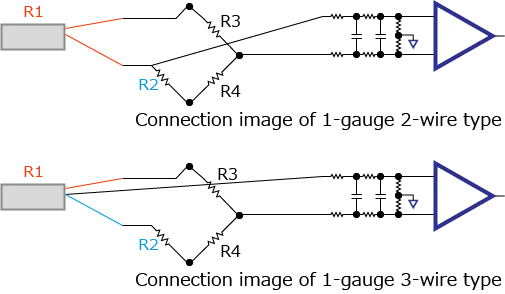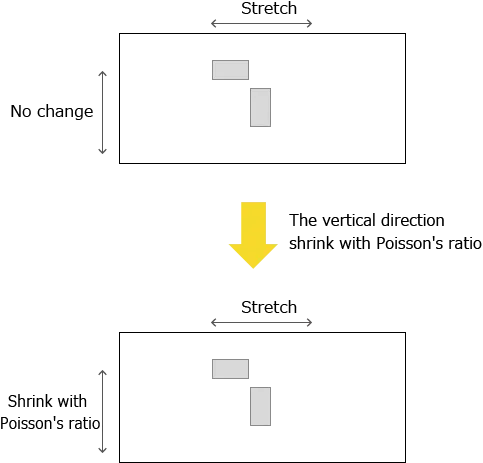Strain Measurement Know-how
 Strain
Strain
 Strain
Strain
Gauge Factor and Measured Value of Strain Gauges
Strain gauge is a film-type sensor with built-in resistance wiring.
The resistance value changes according to the expansion/contraction of the film, and based on the amount of change, the strain value can be deducted.
The strain value is obtained by adding up the change in resistance value and the gauge factor.
As the typical gauge factor of commercially available strain gauges is “2,” AirLogger™ outputs measurement results with a gauge factor of 2.
Please note that due to manufacturing variations, actual strain gauges do not always have a gauge factor of 2.
Check the gauge factor of the strain gauge to be used, and convert it for accurate measurement.
The conversion formula is as follows:
Converted measurement value = measured value / (actual gauge factor / 2)
For a gauge factor of 2.1, the conversion formula is as follows:
Measured value after conversion = Measured value / (2.1 / 2)

The Strain Amount Extracted by a Strain Gauge is the Average Value of the Strain Applied to the Entire Strain Gauge
Strain gauges measure the amount of strain by the change in resistance value caused by the expansion/contraction of the resistors arranged in a linear pattern.
The strain value is the average value of the area where the resistance is set inside the strain gauge.
Accurate measurement is possible by selecting a gauge length that generates strain evenly in the area where the resistance is set inside the strain gauge.

Effect of 1-Gauge 3-Wire Strain Gauge
When measuring the resistance change of a strain gauge using a Wheatstone bridge circuit, the configuration is as shown in the figure.
-
1-gauge 2-wire type:
R1 has two strain gauge wiring resistors attached, and R2 to R4 have no strain gauge wiring resistors. -
1-gauge 3-wire type:
R1 and R2 have one strain gauge wiring resistor attached, and R3 and R4 have no strain gauge wiring resistors.
Since the Wheatstone bridge circuit compares R1/R2 and R3/R4, when the 1-gauge 3-wire type is used, wiring resistors are added to both R1 and R2, which cancels out the error output for wiring.
If balance adjustment for strain measurement is performed, the error in wiring resistance in the 1-gauge 2-wire type is compensated for and the measurement can be made without any issues. However, if there are temperature changes during measurement, twice the temperature change in the resistance of the strain gauge wiring is added as an error in the measurement result.

Measured Values of the 2-gauge Method of Strain Gauges
The 2-gauge method changes the way to calculate the measured value depending on the measurement method.
If the strain gauges are placed on the front and back of the object to be measured, twice as much strain value can be measured.
In case of measuring a component that expands/contracts in only one direction, place the gauge at 90 degrees to the object to be measured, to obtain a x1 strain value.
It is necessary to convert the strain value to a measurement value depending on the location to which the strain gauge is placed.
*Generally, when the object is stretched horizontally, it shrinks vertically. The ratio (i.e. Poisson’s ratio) is determined by the material.

1-gauge method
Strain measurement = (Eo/Ei) x 4/gauge factor
2-gauge method, when gauges are placed on the front and back
Strain measurement = (Eo/Ei)×2/gauge factor
2-gauge method, when gauges are placed at right angles
Strain measurement = (1+Poisson’s ratio)×(Eo/Ei)×4/gauge factor
* In the above formulae, Ei represents the input voltage of the bridge and Eo represents the output of the bridge.
Ei is generated inside the measuring instrument, and there is no need to be separately prepared.

It is necessary to convert the above measurement results to the desired strain amount when using the 2-gauge measurement method to remove the error factor in the 1-gauge measurement method.
If the way the measuring instrument calculates the amount of strain is based on the 1-gauge measurement method, the following conversion must be made.
2-gauge method, when gauges are placed on the front and back
Actual amount of strain = measured strain / 2
2-gauge method, when gauges are stretched at right angles
Actual amount of strain=measured strain / (1+Poisson’s ratio)
AirLogger™ directly outputs the result after the calculation in the measurement result if the calculation is specified in the conversion formula at the setting.
For the conversion formula, please enter the following formula in the red frame in the figure below.
2-gauge method, when gauges are placed on the front and back
“x/2”
2-gauge method, when gauges are placed at right angles
“x/(1+Poisson’s ratio*)”* Poisson’s ratio is determined by the material and is generally in the range of 0.3 to 0.5.












